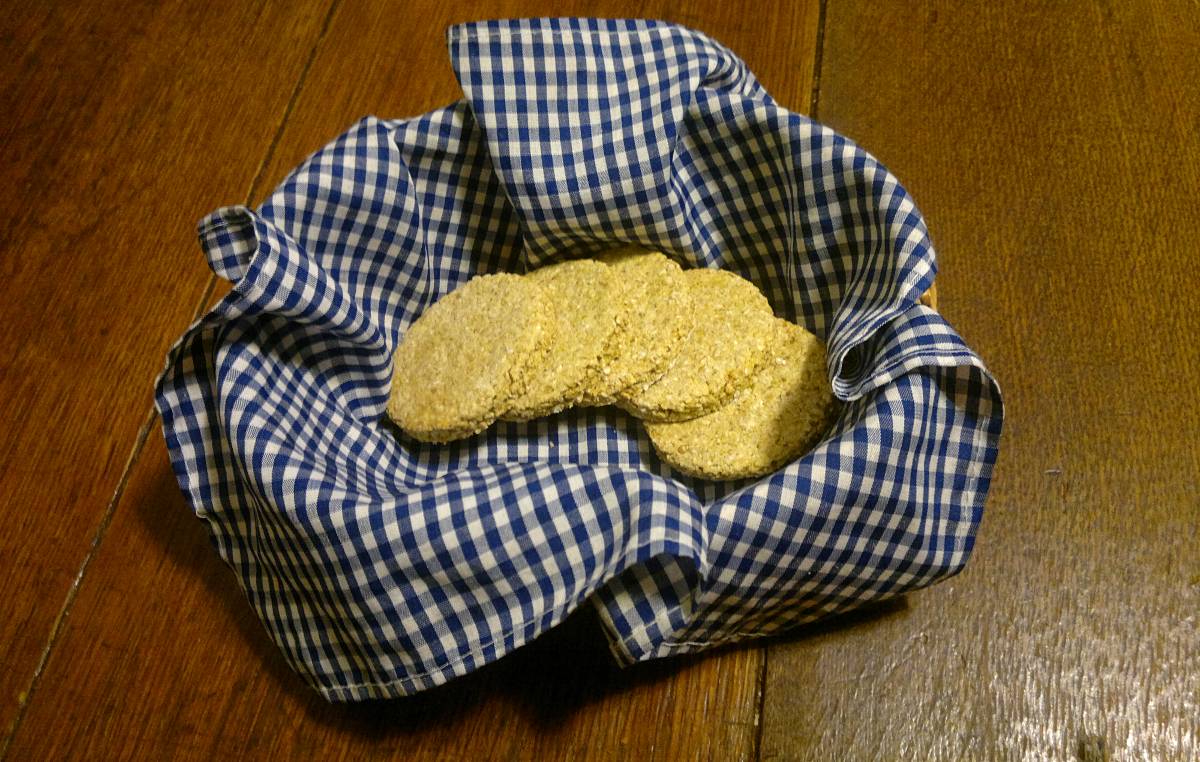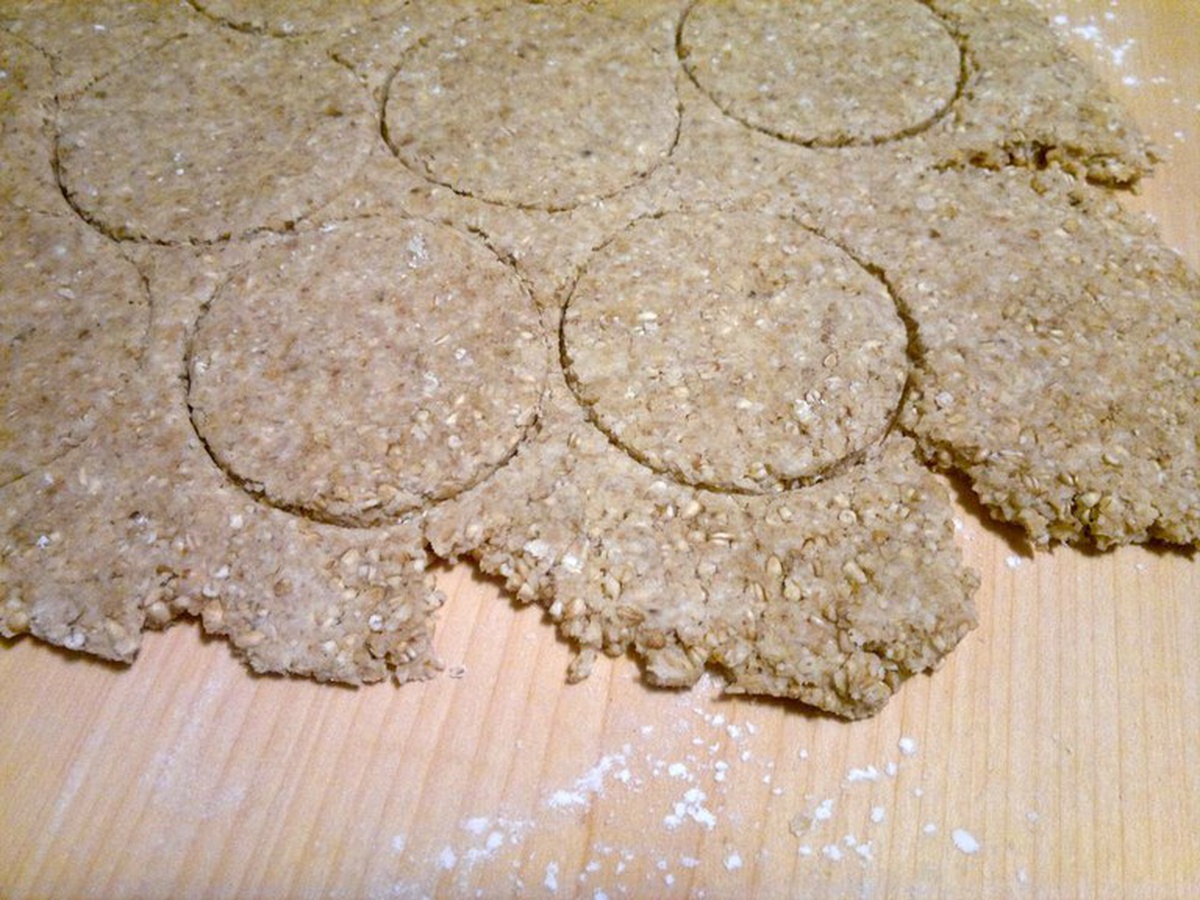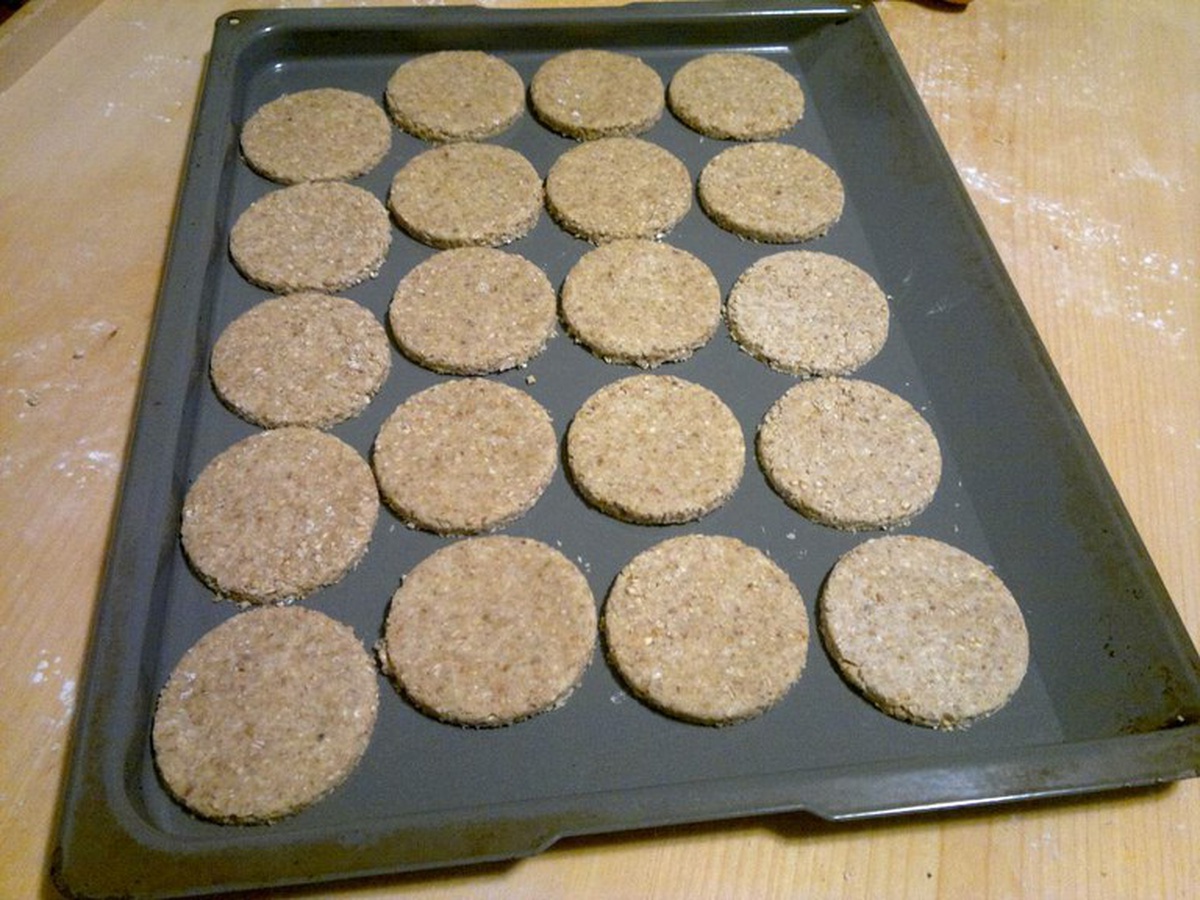For a many years now we have had a tradition of eating oatcakes and blue-veined cheese with a glass of port in the evening during the Christmas and New Year period. Our port wine preference is for an LBV from W&J Graham. This wine is readily available, reasonably priced and very drinkable. Usually, we have Dunsyre Blue cheese but recently all of the Errington Cheese products have been withdrawn from sale. This year we have Hebridean Blue Cheese from the Isle of Mull Cheese company and very nice it is too.

Aran-coirce is the Gaelic name for oatcakes
The real difficulty is finding an oatcake which is "just right". Most commercially produced oatcakes are too refined, too dry and too thin for our liking. The nearest we could find to our liking are the Thick Oatcakes from Stockan's Orkney Oatcakes but they aren't always available locally. If you can't find exactly what you want there is only one answer: make your own.
If you need a recipe for chunky oatcakes with a crunchy texture and not too dry you've come to the right place. Read on, MacDuff.
Ingredients
Ingredients | Quantity |
|---|---|
Oatmeal | 290g |
Pinhead oatmeal | 190g |
Lard or beef dripping | 60g |
Salt | 1/4tsp |
Hot water, about 60°C | 175ml |
Bicarbonate of soda | 1tsp |
Oat or wheat flour for dusting |
Equipment required
- Baking sheets, preferably enamelled or non-stick
- Scone cutter (~7cm)
- Rolling pin
- Mixing spoon
- Palette knife or fish slice
- Medium to large mixing bowl
- Small pan
- Board and/or table
- Cooling rack
- Oven
Method
Ideally the oatmeal, and the equipment, should be at room temperature (~21°C) as otherwise it will significantly cool the other ingredients making it harder to form the oatcakes. For the same reason it is important to work quickly before the oatmeal cools too much.
- Mix together all the dry ingredients in your bowl.
- Melt the fat in the pan and pour into the mixing bowl. Using the spoon mix the oatmeal and fat together.
- Pour in most of the water and using the spoon mix together the oatmeal mixture and the water. The aim is to get a mixture that holds together without bits dropping off but not sticky. If the mixture is too dry add a little more water.
- Test the mixture with a finger tip to make sure it isn't too hot to handle.
- Lightly dust your work surface with a little flour and dump the oatmeal mixture on top. Using your hands work the misture into a smooth rounded shape. Now lightly dust the top of the oatmeal.
- Using the rolling pin start to roll out the oatmeal. Don't worry about getting an even shape, it is more important to get something flat without too many broken edges. You should aim to get the mixture about 5-6mm thick, though this is a matter of preference. Very thin oatcakes using pinhead oatmeal will be very fragile.
- Using the scone cutter cut the oatcake circles but avoid using any areas where the oatcake mixture has come apart. Carefully lift the oatcakes with the palette knife and place them on your baking sheets. The oatcakes can be placed close together, but not touching, as they will not expand sideways.
- Collect all your cut-offs and place them back into the mixing bowl. Using your hands combine all the cut-offs into a ball shape again. It will be neccessary to add a little more warm water (a tablespoon or two at most) to the mixture as working it will have dried it a little. Roll the mixture out again and cut some more oatcakes.
- Step 8 should be repeated until all the oatcake mixture has been used. You may end up with a "baby" oatcake depending on how evenly you divide your mixture. The baby oatcake should be placed in the middle of your baking sheet where it is less likely to completely dry out.
- Place your baking sheets in an oven pre-heated to 200°C and bake for 15 minutes.
- After the initial 15 minutes baking, place your oatcakes in an oven at 70°C for 30 minutes. This second baking is to dry the oatcakes without burning them.
- Lift the baked oatcakes and put them on a cooling rack. The oatcakes can be eaten while they are still warm but should be fully cooled before storing them.
This recipe's ingredients quantity and cutter size, should produce about 32 oatcakes but that is also determined by how thin you roll them out. Thirt-two oatcakes may sound like a lot but once you have eaten one the rest will disappear quickly. You could also halve the quantities in this recipe but why bother dirtying your equipment for just 20.

- When cutting the oatcakes avoid the edges where the dough has cracked.
We usually eat oatcakes with cheese as an alternative to biscuits but they have lots of other uses too.
Notes on ingredients and the recipe method
Even in Scotland ground oatmeal, or oat flour, is not readily available but a very passable alternative can be achieved by putting porridge oats in a food processor and grinding them until a coarse meal is achieved. It is this ground oatmeal that helps bind the oatcakes together, too little and the resultant oatcake will be brittle. The pinhead oatmeal gives the oatcake a crunchy texture.
Lard or beef dripping can be successfully substituted by solid vegetable oil, thus making the oatcakes suitable for vegetarians & vegans. However, I have some concerns about the provenance and health effects of most vegetable oils, so lard or dripping it is for me. Liquid vegetable oil or butter won't give the same results. In comparison to other recipes I use a little more fat as it keeps the oatcakes from tasting dry.
The bicarbonate of soda is used as a raising agent and without it the oatcakes are a little more solid but it also imparts a flavour that some people like. The bicarbonate of soda can be replaced by baking powder if wanted.

- During baking the oatcakes won't expand sideways so they can be placed close together.
Scone cutters are fairly common kitchen utensils in Scottish households but if you don't have any the oatcakes can be cut using something else circular. The inclusion of pinhead oatmeal in the recipe means you need to press quite hard to cut through the un-baked oatcake, a thin drinking glass may not be a suitable substitute. You could cut them into other shapes, like rectangles, but the corners might dry out quicker when baking.
We have an Aga range cooker which has a top oven at a minimum of 200°C and a bottom oven at 70°C and this recipe was developed to make use of this equipment. The secret is to have oatcakes which are warm and moist enough to shape and cut prior to baking. However, most of this moisture needs to be removed to enable the oatcakes to be stored and to have a firm bite when eaten. Thirty minutes in the cool oven will remove the excess moisture without burning the exterior of the oatcake. If you don't have two ovens the same effect can be achieved by removing the partially baked oatcakes and cooling the main oven down to 70°C and then placing the oatcakes in the oven again.
Nomenclature and history of oatcakes
If you've not had oatcakes before the name perhaps conveys the idea of something sweet rather than a flat bread which has the appearance of a biscuit. Cake1 in this sense was also used by Rabbie Burns in his poem On the Late Captain Grose's Peregrinations Thro' Scotland:
In an even earlier period Jean Froissart wrote the following, about Scots' soldiers, in his 14th century Chronicles:
Under the flap of his saddle each man carries a broad plate of metal; behind the saddle, a little bag of oatmeal; when they have eaten too much of the sodden flesh, and their stomachs appear weak and empty, they place this plate over the fire, mix their oatmeal with water, and, when the plate is heated, they put a little of the paste upon it and make a thin cake, like a cracknel or biscuit, which they eat to warm their stomachs.
Froissart was describing the method used by soldiers to make oatcakes using very portable equipment but Scottish households would have done something very similar up until recent times. Ovens didn't become common household appliances in Scotland, or anywhere in Europe, until the 20th century. Baking goods prior to this would have been done on a girdle over an open fire. Girdles were heavy cast iron pans with a flat platter, the baking surface, and a semi-circular handle which also acted as the means to hang it over the fireplace. Baking oatcakes on a girdle is a very rewarding experience but requires a lot more skill than doing it in the oven(s) as described above.
Oats and barley were the staple grains used in Scotland when elsewhere in much of Europe wheat was eaten instead. In most parts of Scotland the climate and conditions are not conducive to growing wheat and the hardier oats and barley were more suitable crops. The witty, but un-attributed2, reposte to Samuel Johnson when he was questioning Boswell's habit of eating oats for breakfast illustrates this difference:
Samuel Johnson:"In England we wouldn't think of eating oats. We only feed them to horses."James Boswell:"Well, maybe that's why in England you have better horses, and in Scotland we have better men".
Notes
- I'll return to the nomenclature of cakes, biscuits and breads when I blog about bannach or bannock, as the word is used in Scots and English.
- It's a nice quote but was likely not spoken by Boswell. The similar retort "Yes, and where else will you see such horses and such men?" was reportedly said by Patrick Murray (Lord Elibank). The reporting was done by, none other than, James Boswell in his book The Life of Samuel Johnson, LL.D.: Including a Journal of His Tour to the Hebrides.